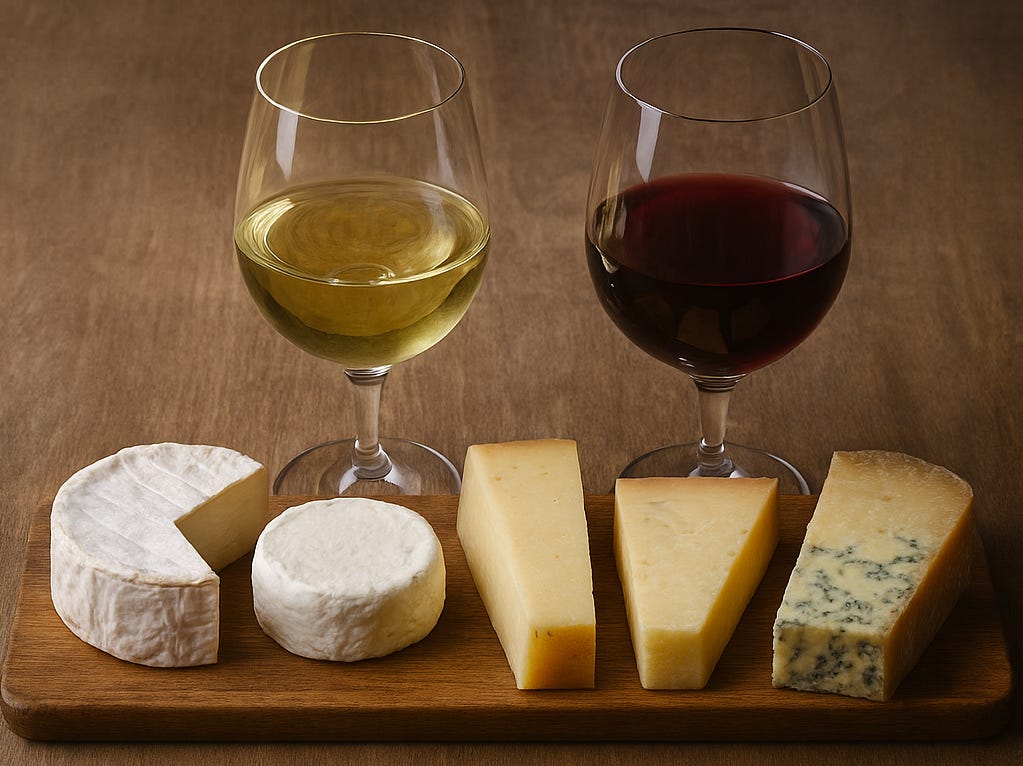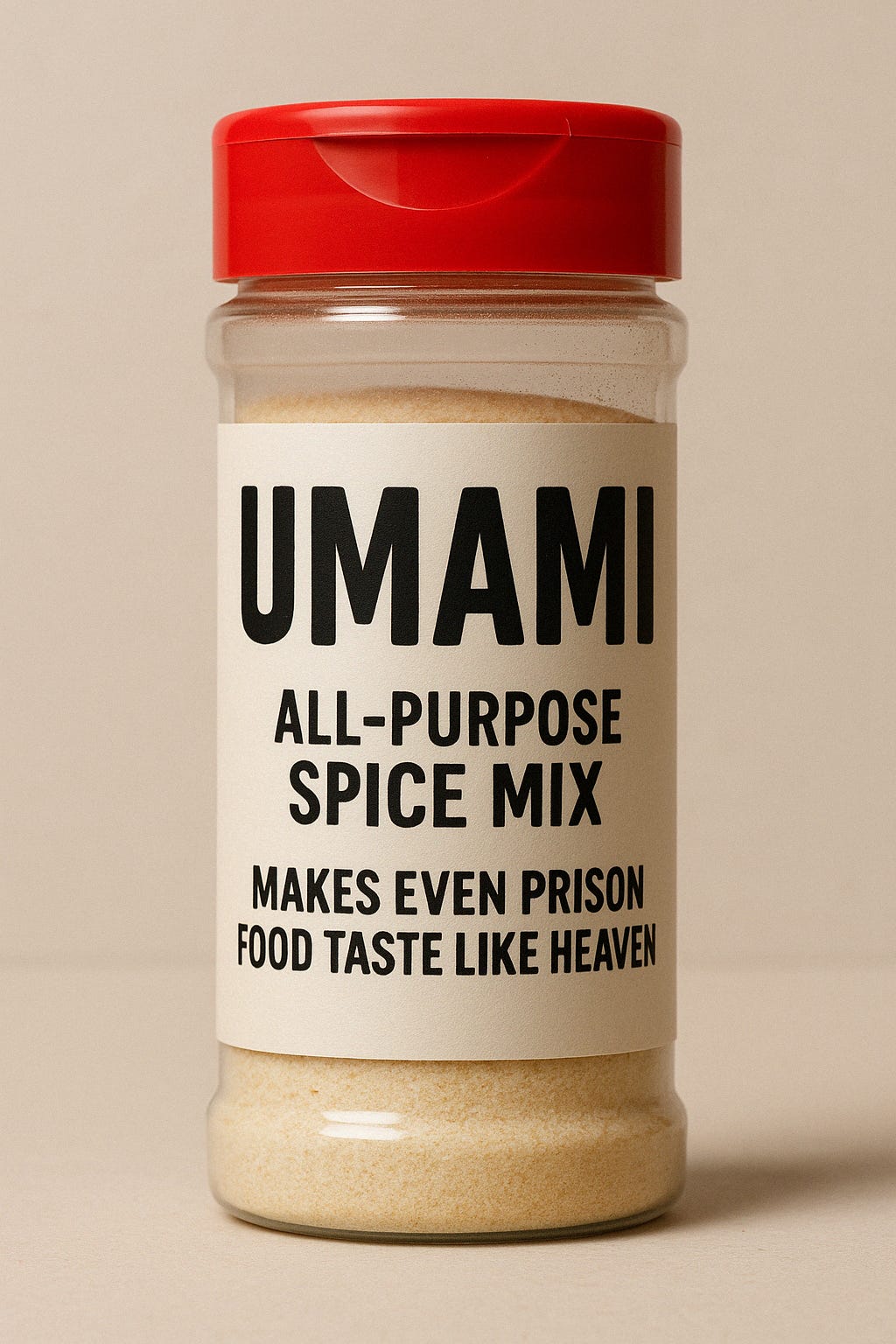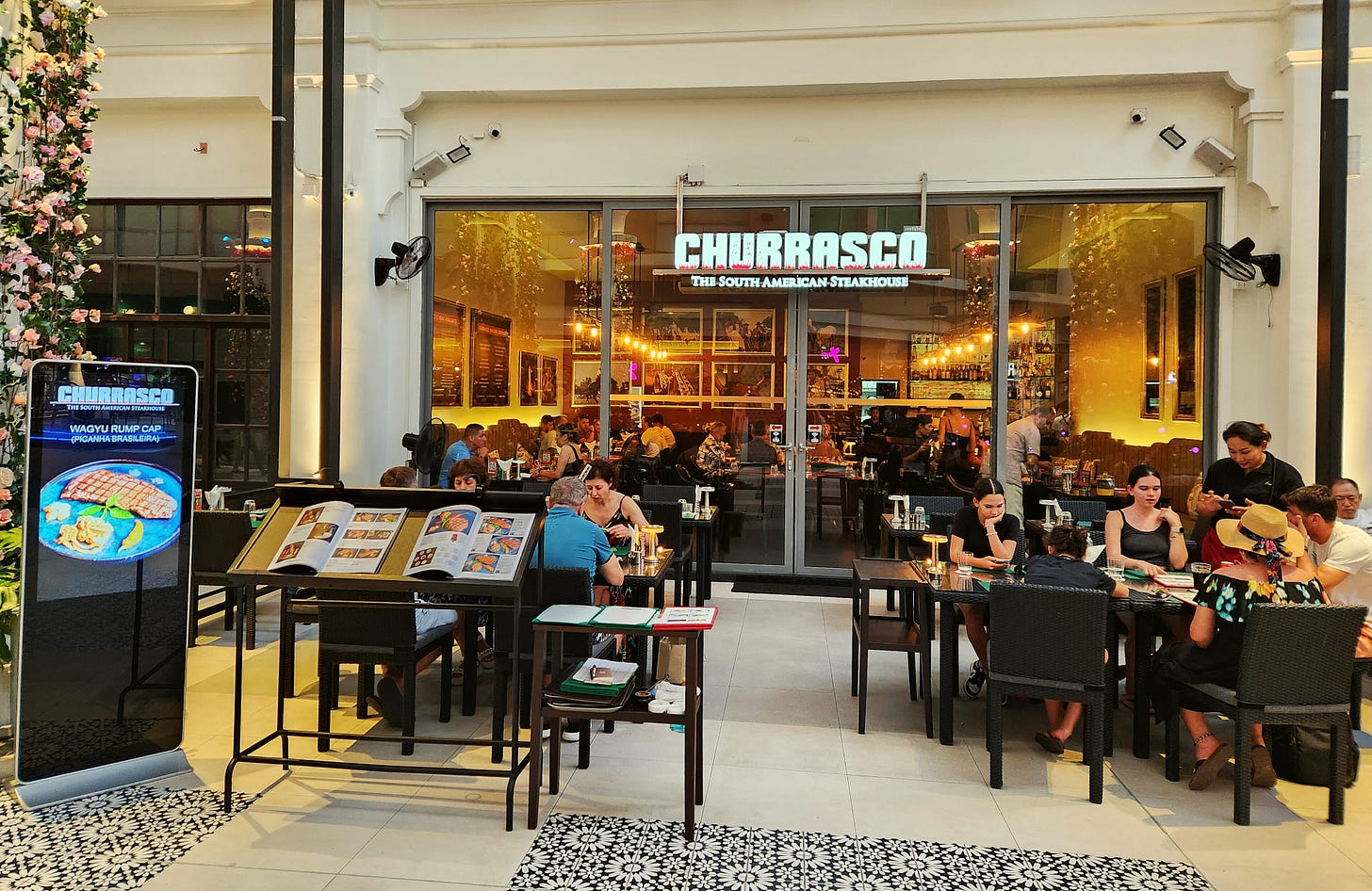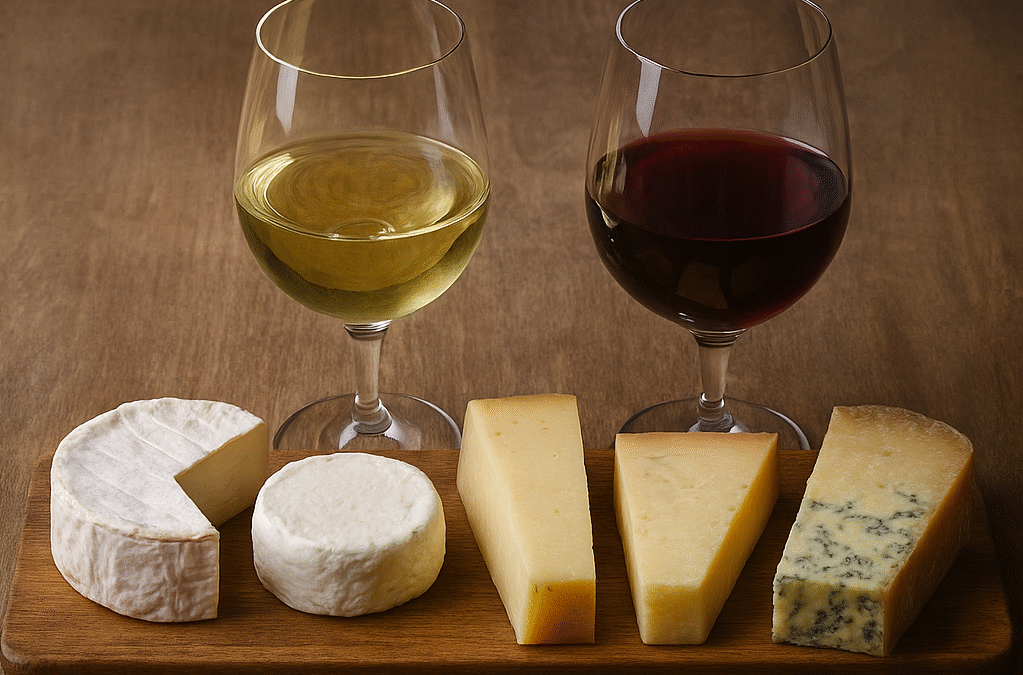
by Ross Kingsley | May 4, 2025 | BLACK BOX: RANTS, RAVES, REVIEWS & RECIPES
One foodie debate that stirs up passionate opinions is the age-old question: red or white wine with cheese? It’s a never-ending battle—even so-called experts can’t agree. Some insist red is the only civilized choice, while others swear by the crisp harmony of a good white. So, at our own peril, we’re wading into the fray to try and settle this delicious dilemma once and for all.
The surprising twist? White wine often comes out on top. While red wine can be wonderful with the right cheese, it’s not always as versatile. Whites tend to offer higher acidity and fewer tannins, which makes them a better match for many cheeses, especially soft or tangy varieties.
Let’s break it down by cheese type so you can confidently build the perfect pairings—whether you’re entertaining guests or just treating yourself.
1. Soft, Bloomy-Rind Cheeses
Think: Brie, Camembert, Triple Cream
These cheeses are lush, creamy, and downright indulgent. They benefit from something that refreshes the palate between bites.
Best Pairings:
Sparkling wines and crisp whites cut through the richness and enhance the buttery flavors without overpowering them.
2. Fresh Cheeses
Think: Goat Cheese, Feta, Ricotta, Mozzarella
Light, tangy, and often slightly salty, these cheeses are a natural match for bright, acidic wines.
Best Pairings:
-
Sauvignon Blanc
-
Albariño
-
Vermentino
The zesty citrus notes in these wines echo the freshness of the cheese and cleanse the palate beautifully.
3. Washed-Rind Cheeses
Think: Taleggio, Époisses, Munster
Washed-rind cheeses can be, let’s say…aromatic. Their bold, funky character calls for equally assertive partners.
Best Pairings:
-
Gewürztraminer
-
Pinot Gris
Aromatic whites handle the funk with flair, offering fruit and spice notes that complement rather than compete.
4. Semi-Hard Cheeses
Think: Gruyère, Comté, Jarlsberg
Nutty and buttery with a bit of age, these cheeses are the friendliest to pair with a range of wines.
Best Pairings:
-
Chenin Blanc
-
White Burgundy
-
Pinot Noir
-
Dolcetto
Red or white can both shine here—as long as you avoid heavy tannins. Pinot Noir’s soft fruit and acidity work well, while whites bring balance and a clean finish.
5. Hard Aged Cheeses
Think: Aged Cheddar, Manchego, Parmigiano-Reggiano
Salty, complex, and bold, these cheeses can finally hold their own against a robust red wine.
Best Pairings:
-
Cabernet Sauvignon
-
Tempranillo
-
Zinfandel
-
Malbec
Tannins in these reds mellow out with the fat in the cheese, creating depth and savoriness in every sip and bite.
6. Blue Cheeses
Think: Roquefort, Gorgonzola, Stilton
Blue cheese is strong, salty, and a bit divisive—kind of like this red-vs-white debate. The solution? Go sweet.
Best Pairings:
-
Sauternes
-
Port
-
Spätlese Riesling
The sweetness softens the sharp edge of the cheese and creates an indulgent, almost dessert-like experience.
Final Thoughts
So, who wins—red or white? The answer: both, depending on what’s on your cheese board. White wines offer more flexibility, especially with fresh, creamy, or tangy cheeses. But aged or hard cheeses can absolutely shine next to a structured red.
Ultimately – and just like in any relationship – the best pairing is the one that makes you happy. Try different combinations, and discover new favorites (wink wink). And remember, wine and cheese are meant to be enjoyed, not argued over … at least not too much.
Image Credit: https://churrascophuket.com
_ _ _
© CHURRASCO PHUKET STEAKHOUSE / ALL RIGHTS RESERVED
Reprinting, reposting & sharing allowed, in exchange for a backlink and credits
Churrasco Phuket Steakhouse serves affordable Wagyu and Black Angus steaks and burgers. We are open daily from 12noon to 11pm at Jungceylon Shopping Center in Patong / Phuket.
We are family-friendly and offer free parking and Wi-Fi for guests. See our menus, reserve your table, find our location, and check all guest reviews here:
https://ChurrascoPhuket.com/
#Churrascophuket #jungceylon #phuketsteakhouse #affordablewagyu #wagyu
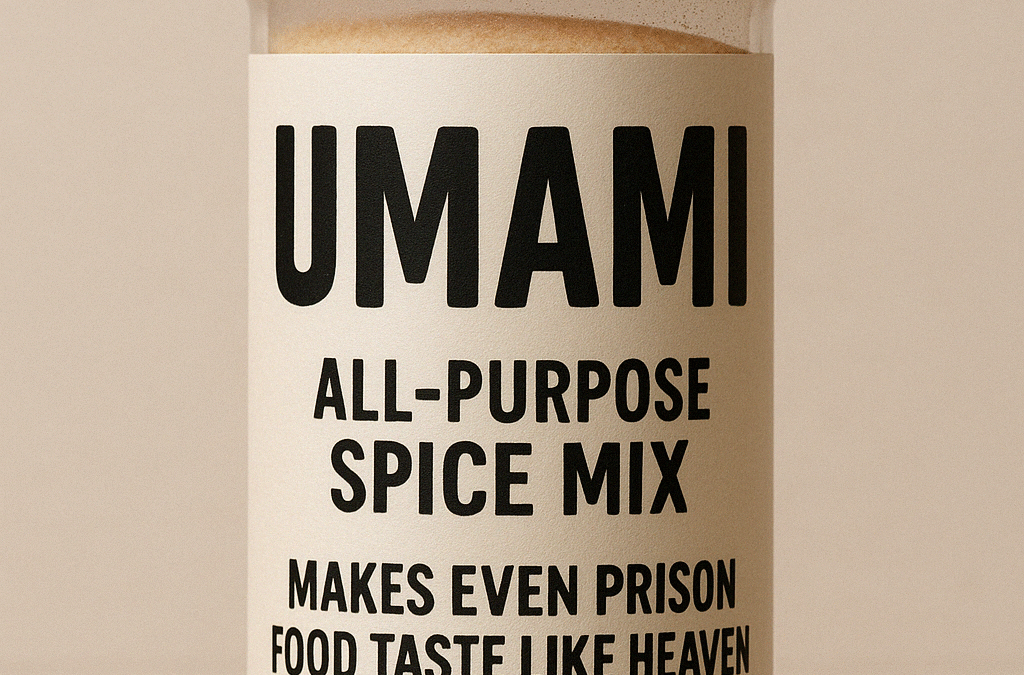
by Ross Kingsley | Apr 27, 2025 | BLACK BOX: RANTS, RAVES, REVIEWS & RECIPES
Once upon an ancient time, food had four tastes: sweet, salty, sour, and bitter. It was a simpler era—steak tasted like steak, tomatoes like tomatoes, and nobody tried to elevate instant noodles by calling them a “celebration of umami.” But then came the rise of a fifth taste, the elusive umami, and everything changed.
Suddenly, umami was everywhere. No dish could be properly described without invoking it. Parmesan? Umami bomb. Soy sauce? The essence of umami. Mushrooms? They scream umami, darling. It’s as if food critics and influencers discovered a magic word that instantly made their descriptions sound more refined. But here’s the thing: it didn’t make them smarter. It just made them louder.
The Myth of the Mysterious Fifth Taste
Let’s get one thing straight—umami isn’t new. Japanese scientist Kikunae Ikeda identified it over a century ago in 1908, after studying the savory depth of dashi broth made from kombu. He isolated glutamic acid as the compound responsible, and thus the “fifth taste” was born. But what began as a legitimate scientific breakthrough has since been co-opted by a certain crowd who like their food writing with a side of self-importance.
These days, people wield the word umami like a chef’s knife at a dinner party, hoping it will slice through their guests’ perceived ignorance. “Oh, you don’t taste the umami in this anchovy-laced butter? It’s sublime—it just lingers on the back of your tongue.” Translation: I read one Bon Appétit article and now I think I’m Harold McGee.
You Keep Using That Word…
Here’s a fun challenge: next time someone says umami, ask them to describe it. Watch the panic behind their eyes. Most will give you some vague combination of “savory,” “meaty,” or “like soy sauce, but not.” It’s the culinary equivalent of someone insisting they love modern art but can’t name a single painter post-Warhol.
Yes, umami is real. Yes, it adds depth and roundness to food. No, it is not a free pass to sound cultured. Throwing around the term without understanding it is like calling every sparkling wine “Champagne.” Technically, you might impress a few, but anyone who knows what they’re talking about is quietly judging you.
MSG: The Original Umami Villain
Let’s also talk about the hypocrisy of the umami elite. The same people who sneer at processed food will wax poetic about umami-rich ramen—then recoil in horror at the mention of monosodium glutamate. Never mind that MSG is literally the concentrated form of umami. Never mind that it’s been proven safe repeatedly. No, it must be “natural” umami or nothing. Preferably extracted by a monk in Kyoto and stirred with a bamboo paddle while chanting.
This fear of MSG is a holdover from a now-debunked panic known as “Chinese Restaurant Syndrome,” which—spoiler alert—was rooted in racism more than science. But hey, sprinkle some truffle salt on it and call it “artisanal glutamate” and we’re back in business.
The Umami Checklist
In case you were wondering, here’s a non-exhaustive list of things people now claim are umami-rich: aged cheeses, cured meats, tomatoes (especially sun-dried, of course), seaweed, soy sauce, miso, anchovies, mushrooms, fish sauce, green tea, slow-roasted onions, and apparently their own egos.
It’s almost comical how everything has become umami if you just believe hard enough. Is your soup bland? Add more umami. Is your restaurant not getting good reviews? Tell the critic your flavor profile leans heavily on umami and they’ll probably nod approvingly, too embarrassed to admit they don’t know what you mean.
A Taste of Humility
There’s nothing wrong with appreciating depth in flavor. But let’s retire the umami name-dropping unless you actually know what you’re talking about. It’s a taste, not a religion. You don’t need to chant it before meals or offer burnt offerings to the god of kombu. Sometimes, your pasta sauce just tastes good because it has garlic, salt, and tomatoes—not because it’s some transcendental umami experience.
At the end of the day, food is meant to be eaten, not intellectualized into oblivion. So next time someone at the table calls their cheeseburger “a rich interplay of umami-forward elements,” do us all a favor—take a bite, chew slowly, and remind them: it’s just lunch.
Image Credit: https://churrascophuket.com
_ _ _
© CHURRASCO PHUKET STEAKHOUSE / ALL RIGHTS RESERVED
Reprinting, reposting & sharing allowed, in exchange for a backlink and credits
Churrasco Phuket Steakhouse serves affordable Wagyu and Black Angus steaks and burgers. We are open daily from 12noon to 11pm at Jungceylon Shopping Center in Patong / Phuket.
We are family-friendly and offer free parking and Wi-Fi for guests. See our menus, reserve your table, find our location, and check all guest reviews here:
https://ChurrascoPhuket.com/
#Churrascophuket #jungceylon #phuketsteakhouse #affordablewagyu #wagyu

by Ross Kingsley | Apr 20, 2025 | BLACK BOX: RANTS, RAVES, REVIEWS & RECIPES
The word churrasco evokes the irresistible aroma of meat sizzling over open flames, but its meaning and culinary significance stretch far beyond just a grilled steak. Rooted deeply in South American tradition, the term has evolved over centuries to represent not just a cooking method, but an entire cultural experience. Today, churrasco has found homes far from its origins—including Phuket, Thailand—where it continues to impress meat lovers with its bold flavors and festive presentation.
The Etymology of “Churrasco”
The term churrasco originates from Portuguese and Spanish, and its earliest recorded use traces back to Iberian pastoral traditions, where gauchos (South American cowboys) cooked meat over open fires on the Pampas. While the precise etymology remains uncertain, many believe it’s derived from indigenous or old Iberian expressions relating to roasted meat.
As Spanish and Portuguese settlers brought their languages and customs to South America, churrasco evolved regionally, becoming synonymous with specific grilling methods and communal dining practices.
Brazil: Churrasco as a Cultural Ritual
In Brazil, churrasco is more than just grilled meat—it’s a social event, often held in backyards or at churrascarias (Brazilian steakhouses). The Brazilian version typically involves skewering large cuts of beef, pork, chicken, or even sausage, then slowly roasting them over a churrasqueira (barbecue grill), traditionally fueled by charcoal or wood.
The meat is seasoned simply with coarse salt and carved tableside in the classic rodízio style, where servers circulate through the dining room offering various cuts until the guest signals they are full. It’s a format that emphasizes abundance, choice, and the joy of sharing food.
Argentina and Uruguay: Asado vs. Churrasco
In neighboring Argentina and Uruguay, the term churrasco does exist, but it generally refers to a thin steak, usually grilled and served with chimichurri sauce. However, the more culturally prominent term is asado, which refers both to the meat and the cooking technique, often involving a wood fire and a slow, deliberate grilling process.
In these countries, the social function of meat grilling mirrors that of Brazil: it’s a ritual, a gathering, and a national pride.
Chile: Simplicity with a Unique Touch
In Chile, churrasco commonly describes a sandwich made from thinly sliced beef, typically served on a bun with ingredients like avocado, mayonnaise, tomato, and sauerkraut. Unlike the barbecue-heavy interpretations in Brazil or Argentina, the Chilean churrasco leans more toward street food and casual dining but retains the essence of grilled beef as the star of the dish.
Churrasco Around the World
The popularity of churrasco has transcended South America. Variations of churrasco-style grilling are now found globally, particularly in the United States, Europe, and Asia. Many steakhouses adopt the rodízio model to offer an immersive, all-you-can-eat experience. Yet, few establishments manage to balance authenticity, quality, and affordability as successfully as Churrasco Phuket Steakhouse in Thailand.
Churrasco Phuket Steakhouse: Tradition Meets Value
Founded in January 2012, Churrasco Phuket Steakhouse has brought the spirit of Brazilian churrasco to the heart of Patong. Unlike many international adaptations that dilute the original intent, this steakhouse honors the core traditions—quality cuts, proper grilling techniques, and a warm, service-oriented atmosphere.
What sets Churrasco Phuket apart is its emphasis on value for money. While many steakhouses in Phuket veer toward exorbitant pricing, Churrasco Phuket offers premium Wagyu steaks and burgers at competitive prices. Regular favorites like Picanha, Ribeye, Tenderloin, and Oyster Blade are cooked to exacting standards—especially their medium rare, which regulars claim is always nailed to perfection.
Conclusion: A Term That Means More Than Meat
From the gauchos of Brazil to the cosmopolitan beaches of Phuket, churrasco has traveled far—without losing its roots. It remains a symbol of communal dining, quality meat, and culinary heritage. Whether you’re savoring skewered cuts in Porto Alegre or biting into a juicy Wagyu burger in Patong, you’re tasting more than just grilled meat. You’re experiencing a piece of cultural history, carried through flame and flavor.
Image Credit: https://churrascophuket.com
_ _ _
© CHURRASCO PHUKET STEAKHOUSE / ALL RIGHTS RESERVED
Reprinting, reposting & sharing allowed, in exchange for a backlink and credits
Churrasco Phuket Steakhouse serves affordable Wagyu and Black Angus steaks and burgers. We are open daily from 12noon to 11pm at Jungceylon Shopping Center in Patong / Phuket.
We are family-friendly and offer free parking and Wi-Fi for guests. See our menus, reserve your table, find our location, and check all guest reviews here:
https://ChurrascoPhuket.com/
#Churrascophuket #jungceylon #phuketsteakhouse #affordablewagyu #wagyu

by Ross Kingsley | Apr 13, 2025 | BLACK BOX: RANTS, RAVES, REVIEWS & RECIPES
I recently returned from a week in New York, the amazing city I once lived and worked in. While much has changed, one thing in particular has spiraled completely out of control—tipping culture. I’ve always understood and respected the principle behind tipping: rewarding good service, boosting morale, and providing a financial cushion for those in underpaid roles. But what one encounters now goes way beyond reasonable appreciation—it felt more like a compulsory tax disguised as generosity.
Everywhere I went—from sit-down restaurants to coffee counters to takeout spots—there was an automatic expectation of a 20% (or more) tip. No nuance. No evaluation of service. Just an unspoken rule that anything less than 20% was somehow insulting. And it wasn’t just the diners and staff perpetuating it; it’s the business model itself. Restaurant owners have effectively shifted the responsibility of paying their staff from themselves to us, the guests.
Let me be clear—I’m not against tipping when it makes sense. A waiter who’s attentive and knowledgeable, a bartender who remembers your preferences, or a delivery person braving the cold to bring your dinner—yes, they deserve something extra. But the current system doesn’t really encourage better service. It simply pressures everyone to tip, regardless of how good or bad the experience was. It’s not a reward anymore; it’s a given.
What’s worse is that many restaurants now calculate suggested tips based on the post-tax total, which is quietly manipulative. And kiosks—those ever-present touchscreen payment terminals—flash 20%, 25%, and 30% suggestions without even giving a “no tip” option unless you go hunting for it. The psychological pressure is undeniable, especially when the person serving you is standing right there, watching.
Even more alarming is the growing push to make tips tax-exempt, which is gaining support under the claim that it helps workers keep more of their earnings. But all this will do is make the system more entrenched and less accountable. Instead of reforming the wage structure, it simply cements an already flawed workaround. Tips are meant to be optional and performance-based. Making them tax-free turns them into a protected income stream—one that businesses can continue to exploit without improving base pay or employment conditions.
In the end, this culture doesn’t actually elevate service standards. If anything, it discourages staff from going the extra mile, since the tip is expected no matter what. There’s no real incentive to exceed expectations because gratuity has become guaranteed.
As someone who’s in the hospitality business, I understand the grind and dedication it requires to succeed. And I know how important tips are. But the system should support workers through fair wages, not guilt-driven donations from customers. If businesses can’t pay livable wages without relying on tips, maybe they shouldn’t be in business at all.
What do you think? Let us know … ?
Image Credit: https://www.churrascophuket.com
_ _ _
© CHURRASCO PHUKET STEAKHOUSE / ALL RIGHTS RESERVED
Reprinting, reposting & sharing allowed, in exchange for a backlink and credits
Churrasco Phuket Steakhouse serves affordable Wagyu and Black Angus steaks and burgers. We are open daily from 12noon to 11pm at Jungceylon Shopping Center in Patong / Phuket.
We are family-friendly and offer free parking and Wi-Fi for guests. See our menus, reserve your table, find our location, and check all guest reviews here:
https://ChurrascoPhuket.com/
#Churrascophuket #jungceylon #phuketsteakhouse #affordablewagyu #wagyu
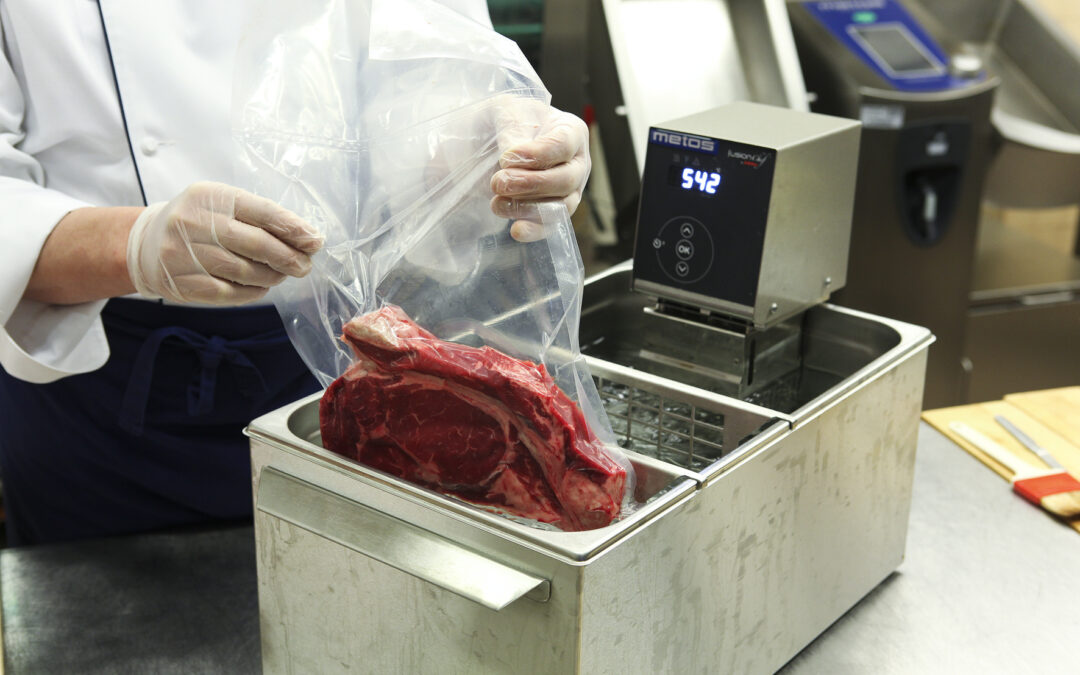
by Ross Kingsley | Apr 6, 2025 | BLACK BOX: RANTS, RAVES, REVIEWS & RECIPES
Sous vide, a French term meaning “under vacuum,” is a culinary technique that has revolutionized the way both professional chefs and home cooks approach food preparation. First developed in the 1970s, this method quickly garnered attention for its ability to produce consistent, high-quality results. Chef Georges Pralus is widely credited with pioneering the technique when he discovered that cooking foie gras sous vide retained its delicate texture and reduced shrinkage during cooking. Since then, sous vide has evolved from a niche practice in fine-dining kitchens to a reliable tool embraced by food enthusiasts across the globe.
At its core, sous vide cooking involves vacuum-sealing food—typically proteins, vegetables, or even fruits—inside a plastic bag, which is then submerged in a temperature-controlled water bath. The precision comes from the use of an immersion circulator, a device that maintains the water at a constant, exact temperature. Unlike traditional cooking methods, where external heat can lead to uneven results or overcooked exteriors, sous vide gently brings food to its target temperature and keeps it there, ensuring perfect doneness from edge to edge.
This method is especially effective for proteins. Steaks come out tender and uniformly pink throughout, chicken remains juicy and fully cooked, and fish flakes delicately without becoming dry. Vegetables also benefit, as sous vide allows them to cook in their own juices or a flavored liquid, preserving both nutrients and taste. Carrots, for example, can retain their bright color and slight crunch while absorbing the flavors of herbs or citrus in the bag.
One of the biggest draws of sous vide is its consistency. It takes much of the guesswork out of cooking, especially when preparing dishes that require precision. This reliability is a significant advantage in restaurant settings, where timing and quality control are critical. Chefs can prepare food well in advance, store it properly, and finish it quickly when orders come in. A steak can be cooked to a precise 54°C (129°F) for medium rare, held at that temperature for hours, and then quickly seared for a caramelized crust before plating.
Beyond proteins and vegetables, sous vide also opens up creative possibilities. Bartenders use it to infuse spirits with herbs, fruits, and spices in a fraction of the time traditional methods require. Pastry chefs use it for delicate custards or crème brûlée, achieving silky textures without the risk of curdling. Even eggs benefit, as sous vide allows them to be cooked to exact levels of firmness—ideal for dishes like eggs Benedict.
Despite its advantages, sous vide cooking does come with its own set of challenges. First, it requires planning. While the technique offers control and precision, it also demands patience—some preparations can take several hours or even days. Short ribs, for example, may be cooked sous vide for up to 48 hours to achieve perfect tenderness.
Another important consideration is food safety. Vacuum sealing creates an anaerobic environment, which can be conducive to certain bacteria if not handled properly. Therefore, strict hygiene and proper storage are essential. Additionally, while sous vide excels at internal doneness, it does not produce the caramelized exterior that many dishes require. To address this, chefs often use finishing techniques such as searing, grilling, or torching after the water bath to develop flavor and texture.
In conclusion, sous vide represents a blend of science, precision, and culinary artistry. It has reshaped modern cooking by offering unparalleled control over texture and flavor. While it demands time and care, the payoff is consistently exceptional results. Whether used in high-end restaurants or home kitchens, sous vide continues to prove its value as a transformative cooking technique.
Image Credit: https://wikipedia.org
_ _ _
© CHURRASCO PHUKET STEAKHOUSE / ALL RIGHTS RESERVED
Reprinting, reposting & sharing allowed, in exchange for a backlink and credits
Churrasco Phuket Steakhouse serves affordable Wagyu and Black Angus steaks and burgers. We are open daily from 12noon to 11pm at Jungceylon Shopping Center in Patong / Phuket.
We are family-friendly and offer free parking and Wi-Fi for guests. See our menus, reserve your table, find our location, and check all guest reviews here:
https://ChurrascoPhuket.com/
#Churrascophuket #jungceylon #phuketsteakhouse #affordablewagyu #wagyu
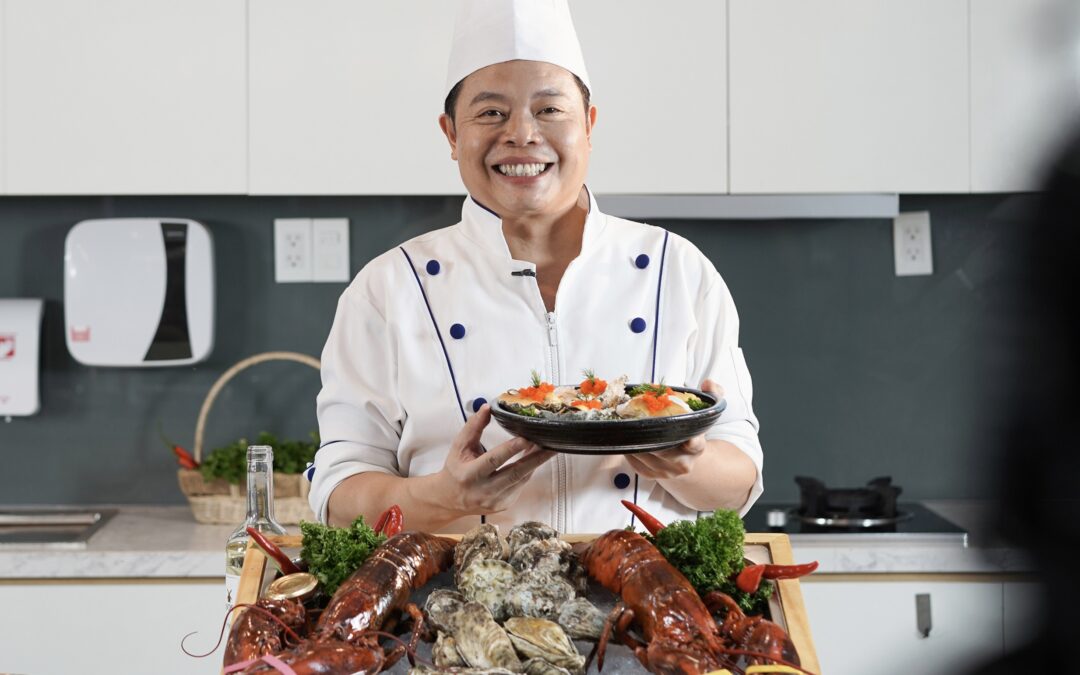
by Ross Kingsley | Mar 30, 2025 | BLACK BOX: RANTS, RAVES, REVIEWS & RECIPES
Born Lý Vinh Viễn in 1970 in Saigon (now Ho Chi Minh City), Chef Jack Lee is a Vietnamese-American celebrity chef, renowned for his innovative fusion cuisine and charismatic presence – both in the United States and Vietnam. His journey is a testament to resilience, passion, focus, and an unyielding spirit.
Early Life and Refugee Experience
Growing up in the bustling Cholon district of Saigon, Lee was immersed in the rich culinary traditions of his Chinese-Vietnamese heritage. However, the aftermath of the Vietnam War brought significant challenges. At the age of 10, Lee and his family fled Vietnam as part of the “boat people,” enduring perilous conditions at sea before being rescued by a Norwegian freighter and eventually resettling in California. This harrowing experience of displacement and survival profoundly influenced his perspective on life and food.
Culinary Aspirations and Professional Development
In the United States, Lee faced the challenges common to many immigrants, including cultural assimilation and language barriers. He learned English by watching the television show “Three’s Company,” identifying with the character Jack Tripper, a chef played by John Ritter. This connection not only helped him adapt to his new environment but also inspired his chosen English name and career path.
Determined to pursue his passion for cooking, Lee enrolled in the California School of Culinary Arts under the Le Cordon Bleu program. His dedication led him to a voluntary position at the prestigious Hotel Bel-Air in Los Angeles, where he started as an unpaid intern working 16-hour days. His relentless work ethic paid off as he climbed the ranks to become the banquet chef, honing his skills in French-Californian cuisine under the mentorship of Chef Humberto Contreras.
Rise to Fame: Chef to the Stars
Lee’s unique fusion of Asian flavors with Western culinary techniques quickly garnered attention. He founded Chinoise Cuisine, a catering company that served high-profile events, including the Oscars and Golden Globes. His clientele featured A-list celebrities such as Angelina Jolie, Michael Jackson, and Steve Jobs, earning him the moniker “Chef to the Stars.” One of his notable creations during this period was the “$100 Egg Roll,” a luxurious twist on the traditional Vietnamese snack, incorporating premium ingredients like Maine lobster tail, Alaskan king crab, Sevruga caviar, and gold leaf, accompanied by a raspberry and Sauvignon Blanc reduction dipping sauce.
Challenges and Resilience
Despite his success, Lee faced significant personal challenges. He underwent surgery that resulted in the temporary loss of his sense of taste—a devastating setback for any chef. This period of adversity tested his resilience, but Lee’s passion for cooking and determination to overcome obstacles saw him through this challenging time.
Return to Vietnam and Television Career
In recent years, Lee returned to Vietnam, where he became a prominent figure in the culinary scene. He served as a judge on “Junior MasterChef Vietnam” and appeared on various Vietnamese cooking shows, including “Món Ăn Của Ngôi Sao” and “Thiên Đường Ẩm Thực.” His engaging personality and expertise endeared him to Vietnamese audiences, further solidifying his status as a culinary celebrity.
Role as Judge on Iron Chef Vietnam
Lee’s reputation culminated in his role as a judge on “Iron Chef Vietnam,” where he evaluated the culinary creations of competing chefs. His participation in such a prestigious program underscored his influence and authority in the culinary world, both in Vietnam and internationally.
Recent Professional Endeavors in the USA
After his impactful stint in Vietnam, Lee returned to the United States, where he continues to share his culinary talents. He has taken on roles as a show chef at various casinos across the country, bringing his unique fusion cuisine to a diverse audience. His ability to blend Asian flavors with Western techniques continues to captivate diners and showcases his versatility as a chef.
Nicknames and Public Persona
Throughout his career, Lee has been affectionately known by several nicknames, including “Mr. Ready,” reflecting his dynamic and ever-prepared approach to cooking and life. His vibrant personality, combined with his culinary expertise, has made him a beloved figure among peers and fans alike.
Philosophy and Legacy
Lee’s culinary philosophy centers on creating awe-inspiring experiences that bring people together to appreciate and enjoy food. He views his diverse cultural background as a rich tapestry that informs his cooking style, allowing him to craft dishes that resonate on multiple levels. His journey from a refugee to a celebrated chef serves as an inspiring narrative of resilience, adaptability, and the unifying power of food.
Conclusion
Chef Jack Lee’s story is one of remarkable transformation and achievement. From his challenging beginnings as a refugee to his ascent as a culinary star, Lee exemplifies how passion, hard work, and an unwavering spirit can overcome adversity. His contributions to the culinary world, both in the United States and Vietnam, have left an indelible mark, inspiring future generations of chefs and food enthusiasts worldwide.
Image Credit: https://www.chefjacklee.com/
_ _ _
© CHURRASCO PHUKET STEAKHOUSE / ALL RIGHTS RESERVED
Reprinting, reposting & sharing allowed, in exchange for a backlink and credits
Churrasco Phuket Steakhouse serves affordable Wagyu and Black Angus steaks and burgers. We are open daily from 12noon to 11pm at Jungceylon Shopping Center in Patong / Phuket.
We are family-friendly and offer free parking and Wi-Fi for guests. See our menus, reserve your table, find our location, and check all guest reviews here:
https://ChurrascoPhuket.com/
#Churrascophuket #jungceylon #phuketsteakhouse #affordablewagyu #wagyu


